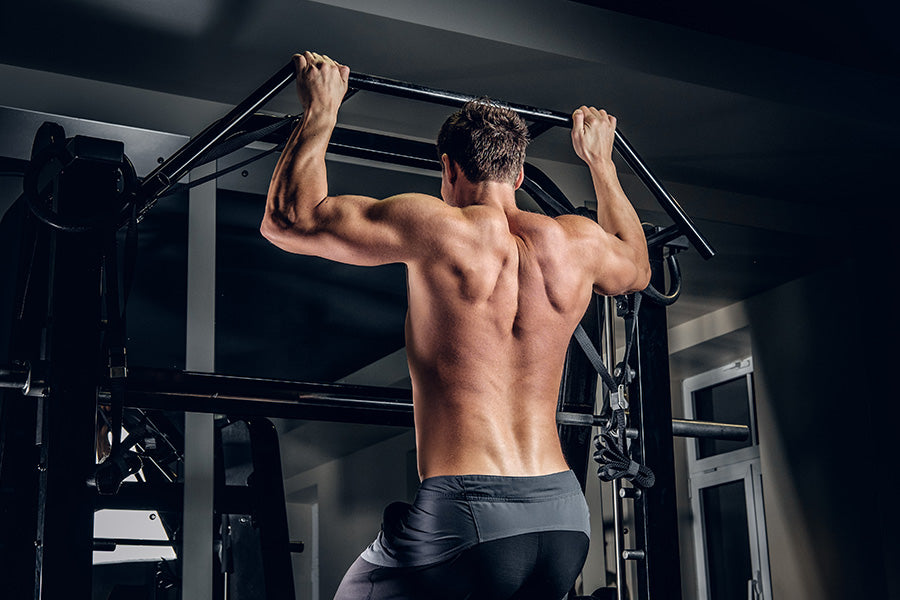We all know the feeling. You've been working out in the gym hard all week, doing your best to stay on track with your fitness goals. But then Sunday rolls around, and you just can't muster up the motivation to get your butt to the gym. It's officially "Rest Day," but you don't want to fall behind, so you do a quick at-home workout instead.
An hour of misery follows as you try to remember how to do all the exercises you've been doing at the gym. You end up Googling half of them, and the other half, you just kind of makeup as you go along. By the time you're done, you're exhausted, your form is terrible, and you're not even sure if you did the exercises correctly. Sound familiar?
Don't worry. We've all been there. That's why we have come up with some of the best pull exercises for people who are short on time (and motivation). So next time you're feeling lazy, give one (or all) of these exercises a try. Trust us, your body will thank you later.
Related Article: 6 Days Pull-Up Workout Plan to Get the Results You Want
Best Pull-Day Workout Exercises
Let's face it: we all dread pull-day workouts. The thought of lugging around heavy weights, doing endless reps, and feeling the burn in our muscles makes us want to hit the snooze button and stay in bed. However, pull-day workouts are essential for building strength and maintaining good posture.
They can be enjoyable if you approach them with the right attitude. Here are a few exercises that will make pull day easier (and much more fun).
Renegade Row

The Renegade Row is a move that will leave your abs screaming for mercy. It's simple: all you need is a dumbbell and your own two hands. But don't let the simplicity fool you. This move is deceptively challenging.
Here’s how to do it:
- Make a push-up position and hold two hex dumbbells in each hand. Your hands should be under your shoulders and parallel to them.
- Lift the dumbbell using your right hand to the side of your hip while maintaining a tight core, tucked elbows, and a straight body from the top of your head to your heels.
- Ensure your elbow is bent 90 degrees, so you are rowing to your hip and not your armpits.
- Return to your starting position after pausing. Once more, row the dumbbell while using your left hand. Continually switch sides.
Resistance Band Pull-Apart

Whether a beginner or a seasoned fitness pro, the resistance band pull-apart is a great move to add to your workout routine. This simple yet effective exercise targets the muscles in your back and shoulders, helping to improve posture and prevent injuries.
Here's how to do it:
- Use a resistance band that offers enough resistance.
- Grab the band in both hands. The more distance you have between your hands the easier it will be and vice versa.
- Exhale as you slowly pull the band apart, keeping tension on the band the entire movement while keeping your shoulders down and your core tight. Pull it so that it reaches your chest.
- Take a breath as you get back to where you were.
Seated Rear Delt Dumbbell Lateral Raise

The seated rear delt dumbbell lateral raise is an excellent exercise for targeting the posterior deltoid or the back of the shoulder. This muscle is often neglected in traditional lateral raise exercises, which focus more on the middle deltoid. This lateral raise variation allows you to keep your core engaged and stabilized throughout the movement.
Here's how to do it:
- Sit with dumbbells in your hands and slightly lean forward. Keep your palms facing each other under your shoulders.
- Exhale while keeping your arms straight. Now, shrug your shoulders and simultaneously elevate the dumbbells to your sides and upper back.
- Keep your arms straight until they are parallel to the ground.
- Return to the beginning posture by inhaling and lowering the dumbbells while keeping a forward torso lean.
Zottman Curl

The Zottman curl is among the most versatile exercises for your arms as it works both the biceps and triceps and can be done with various weights. Most exercises either focus on one muscle group or the other, but the Zottman curl hits both.
Here's how to do it:
- Hold a dumbbell in both hands, standing tall and palms facing forward. Make an underhand grip.
- Curl the weights towards your shoulders and keep your elbows tucked and locked by your sides.
- Turn the dumbbells 180 degrees so that your palms now face the ground. Flip your grip once more (to underhand) to get back to the beginning position after lowering the weights to your sides.
Dumbbell Deadlift

It is a famous variation of classic deadlifts. However, there are many differences between dumbbell deadlifts and barbell ones. It permits a greater range of motion and potential for muscle growth.
Additionally, barbells tend to be more stable than dumbbells, making them ideal for heavier weights. However, this implies that barbells are more challenging to control, leading to injury. Dumbbells, however, are much easier to control and safer to lift. Ultimately, deciding which exercise to perform depends on your individual goals and abilities.
Here's how to do it:
- Choose a pair of dumbbells and place them on the floor in front of you.
- Stand with your feet about shoulder-width apart.
- Drop your hips and reach down to hold the dumbbells with a neutral grip (palms facing inward).
- You might need to elevate or drop your hips slightly to get the optimum, most natural leverage posture.
- Be sure to keep your eyes forward. Keep your head up and your eyes forward because your body will follow!
- Keep your back straight.
- Instead of pulling the dumbbells from the floor, concentrate on standing up with them. As you stand up, lead with your head.
- As you move forward, drive with your heels and explode forward (leading with your head).
- Put your hips forward and compress your back by pulling your shoulder blades back as the dumbbells rise to knee height.
- Pause for a time, and then perform the exercise in reverse by bending at the knees and gradually lowering the weight, strictly controlling the dumbbells as you do so.
- If required, adjust your stance and repeat for the desired reps.
Glute Bridge

The glute bridge is a time-honored exercise that fitness enthusiasts have used for generations. This simple move can be performed virtually anywhere, making it an excellent choice for those who are short on time or equipment.
Here's how to do it:
- Keep your feet flat on the ground, about hip-width apart, with your knees bent.
- Put your hands down on the floor next to you.
- By tightening your hamstrings and glutes, raise your hips off the floor.
- Hold for some seconds, then gradually return to the beginning position by lowering your hips.
- Begin with three sets of 10 to 12 repetitions, then add more as necessary.
Related Article: 7 Practical Things You Can Apply to Make Your Deadlift Easier
Benefits of Pull Days
When it comes to working out, there are various options. But if you're looking for an effective workout targeting all your major muscle groups, you can't go wrong with a pull workout. The following are just a few of the benefits that you can expect from this type of workout:
Improve Performance for Other Exercises
The back is the most important muscle group in any weight room. It provides support for your bench and overhead presses. It’s what supports you while squatting or deadlifting with heavy weights on a barbell, but more than anything else - its strength makes movement patterns like driving forward while pulling up easy.
The key to improving your performance on these exercises is strengthening the back. And one of the best ways for boomers, professionals, and anyone looking into toning up their lower half while losing weight or gaining muscle mass is to follow this pull-day workout routine.
Minimize Muscle Imbalances
When building a solid foundation for your body, you might think spending time working on certain muscles would be more beneficial than others. For example, many weightlifters focus their efforts on fronts, such as the pecs and shoulders, while neglecting other areas like traps or rhomboids behind them.
It may raise your risk of injury and, over time, lead to size and strength imbalances between the muscles on the front and rear of your body, ruining your "aesthetics."
By making sure you spend time working out, you are "pulling" muscles each week, so they never fall too far behind your "pushing" muscles; excellent pull day workouts help you avoid muscular imbalances.
Time-Efficient
There are many different training techniques for muscular development. Still, one of the most time-efficient is doing a single or couple of weekly workouts consisting solely of upper body pull exercises. It allows you to train all your back muscles while hitting bicep cuffs in just one session.
FAQs
1. What exercises can be done for pull day?
The exercises that are supposed to be done for pull day are chin-ups, lat pulldowns, glute bridges, and dumbbell deadlifts; just to name a few.
2. How many pull exercises per workout?
There is no set number of pull exercises per workout. However, performing 3-4 pull exercises per session is generally recommended.
3. Is bicep curl push or pull?
The bicep curl is a pull move.
4. What muscles should you work together?
Here are some of the popular choices:
- Chest and Back
- Quads and Hamstrings
- Biceps, Triceps, and Shoulders
- Glutes and Abdominals
5. What is trained on pull day?
In this workout, you train all your upper body pulling muscles, i.e., the back and biceps.
The Bottom Line
A pull-day workout is a great option if you're looking to tone your back, shoulders, and arms. The best pull-day exercises are Renegade row, glute bridge, dumbbell deadlift, Zottman curl, rear dumbbell lateral raise, and band pull-aparts. They help strengthen your back, minimize muscular imbalance, improve your performance, and are time-efficient. So give them a try and see how they work for you!











